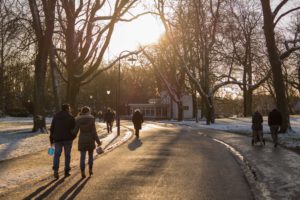The 2019 WAA/DNR Annual Conference was held in Green Bay on February 17-19. This year surpassed last year’s record attendance and showcased a variety of wonderful presenters from across the country. Those in attendance were from the private industry, business owners, municipal staff, and state employees. The conference had five different tracks: general sessions, climbers corner, introductory, business and utility. Across these tracks many topics were covered, from insects and pests to climbing and ensuring morale amongst staff. This three-day conference also hosted many different exhibitors from the industry to provide up-to-date technology, equipment and practices to improve their work. Continue reading “WAA/DNR Conference has another record year!”
Urban wood
Wisconsin tree champions lauded for outstanding community service
CONTACT: Sara Minkoff, DNR Wisconsin Urban Forestry Council liaison, 608-669-5447, Sara.Minkoff@wisconsin.gov
MADISON, Wis. – The Wisconsin Urban Forestry Council recently announced award recipients honoring those dedicated to protecting, preserving and increasing the number of trees that line city streets, fill community parks and beautify neighborhoods throughout the state. The Wisconsin Urban Forestry Council advises the Department of Natural Resources Division of Forestry on the management of urban and community forest resources. Continue reading “Wisconsin tree champions lauded for outstanding community service”
Help your heart by planting trees
February is American Heart Month. Get heart healthy the easy way, head outside! Exposure to trees relaxes and restores your mind, lowering your blood pressure and heart rate. This helps to reduce incidences of cardiovascular and lower respiratory diseases. Conversely, tree loss from the spread of the emerald ash borer, and other insects and diseases, is associated with increased mortality related to cardiovascular and lower respiratory diseases.
August Hoppe inaugurated to the TCIA Board of Directors
“Urban forestry and tree care is a great industry to be involved with and something that we all should be proud of. Industry professionals leave a lasting legacy in caring for the trees in our community each and every day, and it’s important that we spread the word and help future generations understand the importance of nature and trees.” Continue reading “August Hoppe inaugurated to the TCIA Board of Directors”
Markets growing for urban wood across Wisconsin
By Scott Lyon, Forest Products Specialist
Many communities have expressed greater interest in local goods and services over the last few years; as a result, urban wood recycling efforts have increased in Wisconsin. The increase of trees killed by invasive insects and disease caused many municipalities to seek alternative uses for urban wood rather than disposing material in a landfill. Recent efforts to market this growing source of material and develop ways to recycle urban trees within communities led Wisconsin to become one of the leading states in urban wood utilization.

Live edge walnut slab table at a Milwaukee based business.
Throughout the state, markets have started to grow; at least 30 companies are producing products made from urban wood. The City of Milwaukee cut their disposal costs in half by sending their street tree removals to Kettle Moraine Hardwoods and Bay View Lumber. Consumers are drawn to urban wood for its unique character appearance that enhances its use in furniture, cabinets, flooring, millwork, wall and ceiling panels. Urban wood can now be found in large scale projects such as ceiling and wall panels at the new Milwaukee Bucks Arena, and apartment and business buildings in Milwaukee. In both Milwaukee and Madison, the hobbyist wood worker can find urban wood lumber and live edge slabs at the local Habitat for Humanity Restore. Urban wood manufacturers have noted an increase in demand for live edge slabs for use in tables, desks and countertops.
Demand for urban wood has increased not only in Milwaukee and Madison, but across the state in other communities such as Green Bay, Appleton, and Eau Claire. In Eau Claire, urban wood is making some noise (literally) after repurposing in the manufacture of guitars. In addition, the City of Eau Claire has partnered with some Wisconsin Urban Wood members to produce furniture and specialty products. Wisconsin Urban Wood is the brand that assures consumers that the wood originated from Wisconsin’s community forests and passed through an entire supply of Wisconsin-based business to arrive as the final product.
However, a need still exists to help end-consumers and other users, such architects, interior designers, and engineers, understand the benefits and value of using wood and overcome perceived barriers. Wood is a renewable resource as opposed to substitute non-renewable products such as concrete, steel, and plastics.
For more information on urban wood use or to find an urban wood user in your area please visit Wisconsin Urban Wood or the Urban Wood Network.
Urban forestry finds a voice on the Council on Forestry
 “I have an opportunity to be a voice in the conversation.” As a new member of the Council on Forestry, Jordan Skiff, Fond du Lac public works director and Urban Forestry Council chair, will be an advocate for urban and community forestry, sharing its challenges and proclaiming its benefits. Skiff fills the urban forestry seat vacated by Dr. R. Bruce Allison in December 2016. Continue reading “Urban forestry finds a voice on the Council on Forestry”
“I have an opportunity to be a voice in the conversation.” As a new member of the Council on Forestry, Jordan Skiff, Fond du Lac public works director and Urban Forestry Council chair, will be an advocate for urban and community forestry, sharing its challenges and proclaiming its benefits. Skiff fills the urban forestry seat vacated by Dr. R. Bruce Allison in December 2016. Continue reading “Urban forestry finds a voice on the Council on Forestry”
Trees help achieve resolutions to be healthy
The sedentary lifestyle has become more common, and the shift has been costly. One result is an increase in obesity. Childhood obesity rates have tripled (12–19 years old) or quadrupled (6–11 years old,) and adult rates have doubled since the 1970s. Obesity increases risk of chronic diseases and conditions such as: high blood pressure, high cholesterol, diabetes, heart disease, stroke, gallbladder disease, osteoarthritis, sleep apnea, cancer and mental illness. This rise in chronic diseases related to obesity results in billions of dollars in medical costs and lost productivity each year. Continue reading “Trees help achieve resolutions to be healthy”
Master Gardeners increase diversity in Wausau botanical garden
The North Central Wisconsin Master Gardener Association is working to develop a shade garden within the Monk Botanical Gardens located in Wausau, WI. Continue reading “Master Gardeners increase diversity in Wausau botanical garden”
Urban Tree Alliance partners with Community Development Authority to complete tree inventory
The Urban Tree Alliance (UTA) received funding from the WI DNR urban forestry grant program to develop the Housing Partnerships project. Continue reading “Urban Tree Alliance partners with Community Development Authority to complete tree inventory”
Another productive year for Wisconsin urban forestry!
Written by Jeff Roe, Urban Forestry Team Leader
As I reflect on this year, what stands out to me is cohesion and enthusiasm. Within the DNR, Division of Forestry, Urban Forestry Team and with our partners, I feel that communication, enthusiasm and follow-through have been hallmarks of this year.
Continue reading “Another productive year for Wisconsin urban forestry!”

